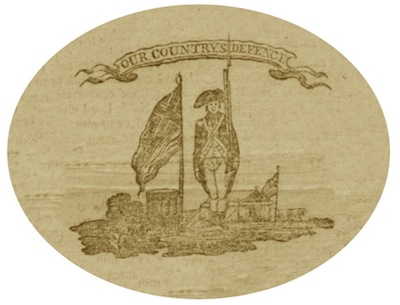During the Napoleonic Wars the threat of invasion by the French caused Britain to strengthen its defences along the south coast in readiness. Initially, more troops were redeployed to the south followed later by other defensive precautions such as the Martello Towers that were built along the Kent and East Sussex coasts. Barracks and camps were set up, most were intended only as temporary accommodation for the troops but the one along the Lewes Road near Brighton became permanent and survived into the 20th century as Preston Barracks. There were others further inland but the local coastal camps were at Blatchington (Hove), Southwick, Steyning, New Shoreham and Worthing.
Preston aside, New Shoreham and Steyning were the most used of these camps that accommodated the soldiers and any wives and children that followed them. Whether it was a requirement of coastal parishes of the time or simply the diligence of the parish clerk, the New Shoreham Parish Records recorded the regimental names against marriage and burial entries for all the soldiers and their wives as well as the baptism of their children. These records have been supplemented by broad-sheet and newspaper reports of the time and far from being a precise record they nevertheless give some idea of the regiments that were billeted to the town and how long they were here.
Throughout the period many different fields and plots of land here and there were used for short periods by the army and militia in various parts of Shoreham. The whereabouts of these less permanent encampments are not yet positively identified but from the owners’ names we have rough idea where they may have been. ‘Warehouse Barracks’ are mentioned in 1795 but not again until 1807 when ‘Malthouse Barracks’ also appears – the first was on Thomas Tillstone’s land, probably the warehouse and land behind his house in John Street that backed on to Middle Street; Thomas Pelham’s malthouse was between Church and Middle streets just above the Customs House there. Did the latter include Pelham’s ‘Guardhouse’ (1795) and did John Hooper’s ‘Hospital Barracks’ (1795) imply that nursing care was provided for troops? Perhaps Captain Charles Hill who rented a house from Mrs Hannington and a yard from J.R.Hawkins (1813) at their property next to the Dolphin Inn was a serving an officer of the encamped army as well?
More precisely an examination of the New Shoreham Land Tax Records in conjunction with the 1782 Survey of the town does however tell us exactly where the most continuously used army camps or barracks were. Perhaps surprisingly, three of them were nearer to the town centre than may have been thought – at the west end of the High Street on two plots of land known as Mill Green and Kings Head and at the east end at Star Gap.
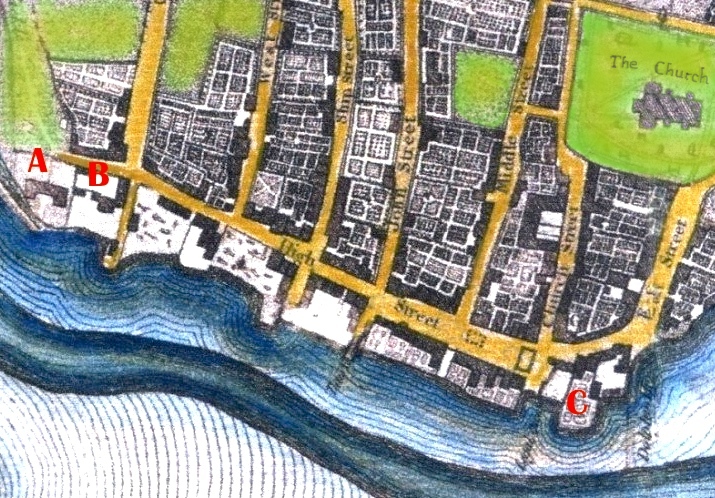
Mill Green Barracks 1801 – 1810 first appear around 1801, owned by John Rice – Mill Green is shown on the 1782 Survey map as being between today’s Ropetackle Hard and the road bridge and extended into about half of the residential block that includes the Arts Centre. The troops were almost certainly accommodated in part of the granary building there. It was a huge structure and one of the store-rooms alone could have housed a considerable number of men. By 1810 the site seems to have reverted to non-military use.
Kings Head Barracks 1801 – 1816 owned by Thomas Tillstone also appears. The Kings Head was thought to have been trading as an inn even as early as 1724 and the property included the land behind it. It is mentioned again in 1807 and again in 1810 by which time ownership had passed to Benjamin Tillstone who remained owner up until 1816, the last time the barracks were included in the Land Tax lists.
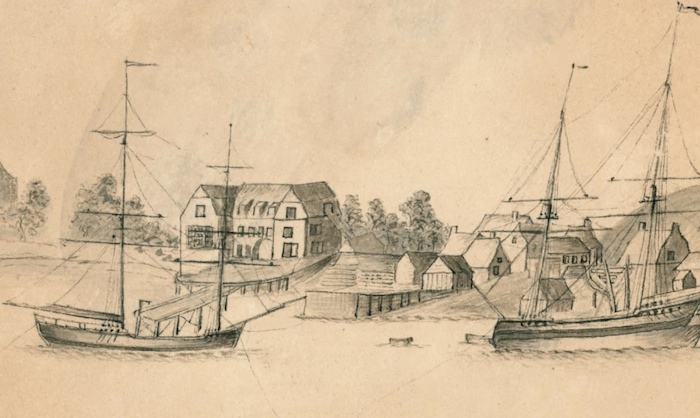
Star Barracks 1801 – 1812
Troops were also accommodated in the old buildings that stood behind the Dolphin Inn that provided ample living quarters there being made up of many rooms with land behind to the river. Star Barracks together with “Starr (sic) Barracks Field” (the land between the buildings and the river that is now Coronation Green) are shown together in 1807.
These groups of buildings are described in the 1782 Survey and conclusively match the 1812 description when the property was sold i.e.,‘…extensive wharfs and buildings called the High Cage and Star Barracks situate adjoining the river ……… comprising a wharf or quay 42 feet by 38, a coal yard walled in…..’ Known as ‘Tall Walls’ in 1782 it was eventually purchased by Thomas Clayton, the Shoreham cement manufacturer, who had his ‘cement manufactury’ there before it became a brewery in the later 19th century. The complete set of buildings known collectively as Dolphin Buildings including the part used for the barracks survived until 1938 when they were demolished for the High Street road widening.
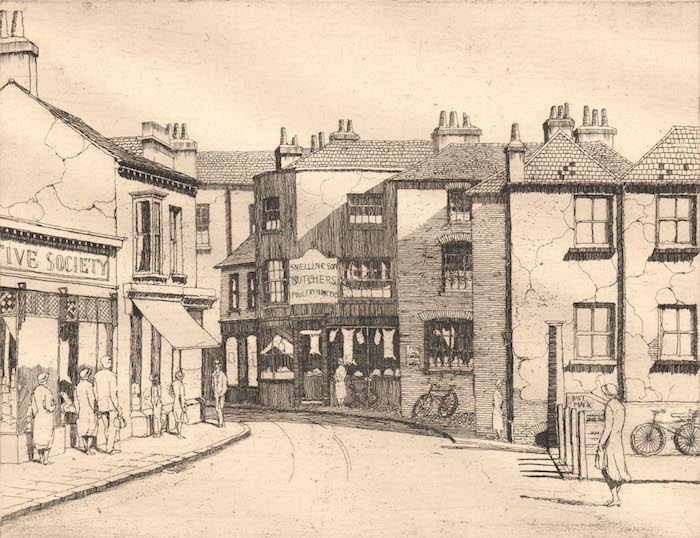
New Barn Barracks circa 1790 –1823. By far the largest was in the combined area of New Barn Field and Wickers Field, the land now bounded by Southdown (then called New Barn Lane) and Ravens Roads on the west, east and south and Mill Lane to the north. It would have been the main Barracks in Shoreham as it was certainly the largest. It is shown under ownership of the Bridger family who owned much of the land and fields to the north of the town then and leased by John Boyce senior but by 1801 Boyce is shown as having purchased it outright.

Cavalry regiments were often stationed at Shoreham and New Barn was the only barracks suitable for both troops and their horses even if (as is probable) just a detachment from the total regimental complement of men and animals were included. This was the lower two-thirds of New Barn/Wickers Fields although it is believed that the top third including the three cottages would also have been used to accommodate the officers and provide an exercise yard for the horses.
Thomas Budgen’s map of 1797 includes Shoreham and shows the barracks and the huts within it. Wooden huts were usually used to accommodate the lower ranks but more substantial living quarters or stabling was also constructed as, in recent times, the remains of flint and mortar walls were discovered in the rear garden of 28 Southdown Road (on the east side of the road) believed to be part of a stable block for the earlier barracks which was mentioned in the older property deeds for the house. Number 28 coincides with what appears to be the main/largest building on the extreme north/west corner of the barracks field.
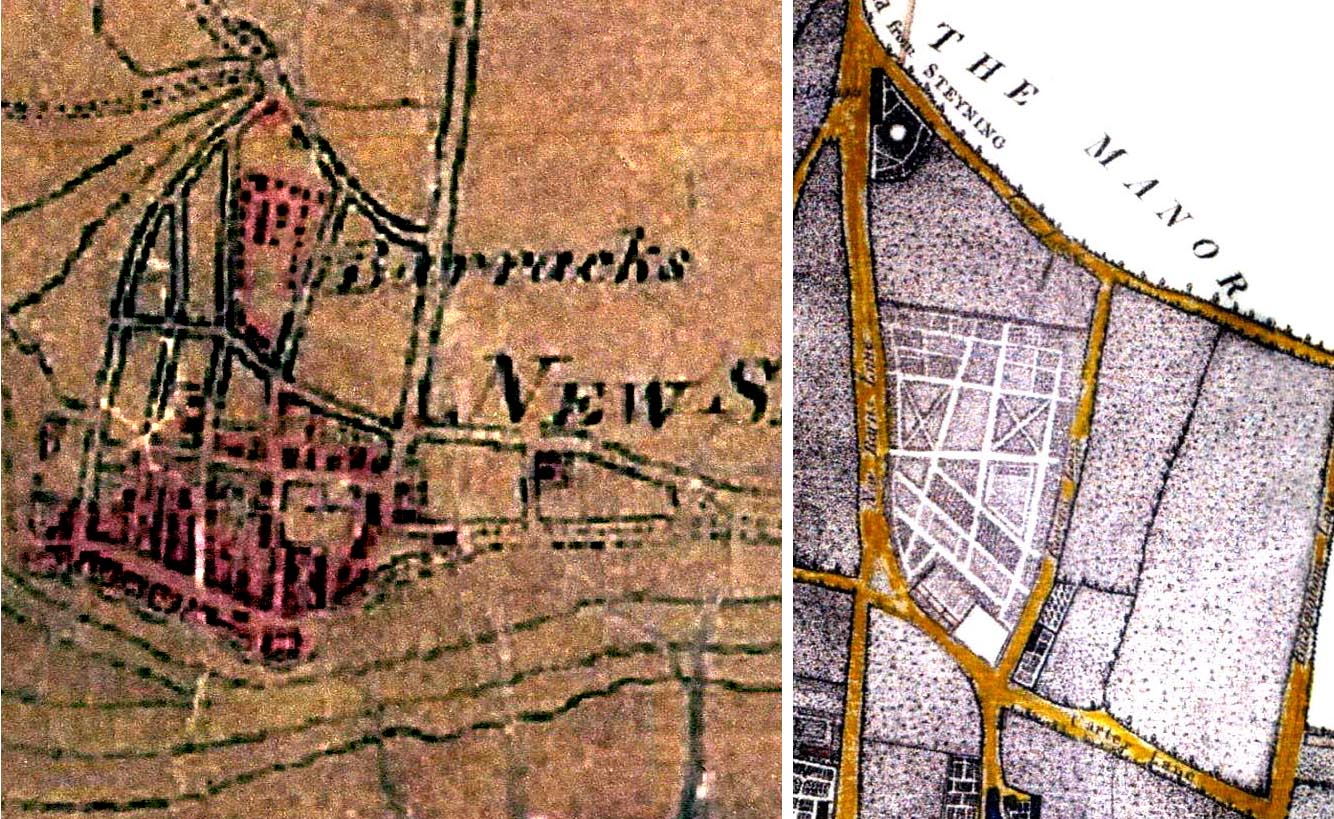
The Budgen map shows an alteration of the New Barn/Wickers fields boundaries from that on the 1782 Survey and this later division is still reflected in the 1817 Shoreham map after the military had left. What is intriguing though is that the apparent later use as cultivated individual nursery/garden plots and paths seems to reflect in part the earlier layout of the camp huts.
More precise details of the buildings there have come to light following the discovery of an advertisement in the Sussex Advertiser of 17th April 1815. The barracks were put up for sale by the Commissioners for the Affairs of the Barracks and comprised:-
‘Unserviceable stores (except bedding) in small lots; Buildings consisting of one Officer’s Mess House, five Officers’ Buildings of three rooms each; two Quarter-Masters’, two Sergeants’ and seven Privates’ Huts; an Hospital; Guard House; Barrack Master’s Store; Straw Barn; Granary; Engine House; Magazine and other Buildings.’
All the buildings were to be taken down and removed at the expense of the purchasers.
Before all this, one of the most common sights in Shoreham would have been the blue coat uniforms of the numerous customs officers in and around the Church Street Custom House. Then the sight of red-coated soldiers in town would also have become increasingly common, especially in the inns and particularly the Kings Head where the Tillstone family as owners would doubtless have benefitted from the custom of their new tenants and of course the Dolphin Inn next to the Star Barracks.
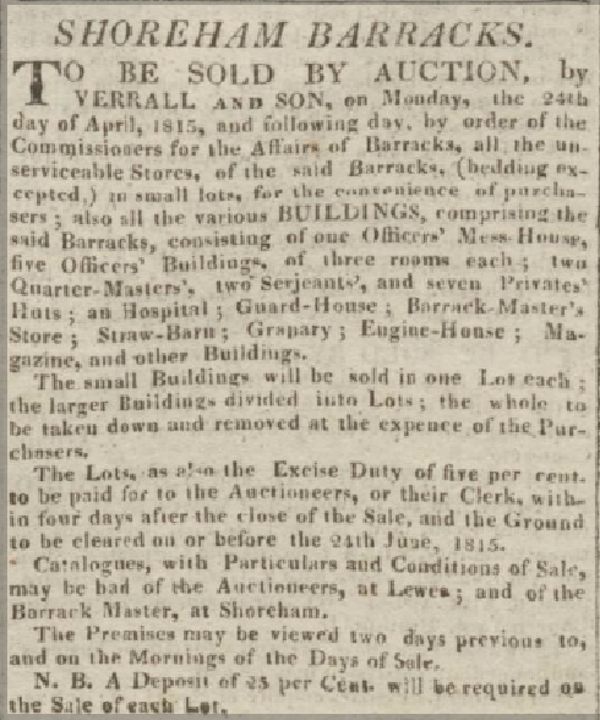
During the earlier years the soldiery was made up of militia from around the country. These were not part of the regular, standing army but county units, used for home defence only and raised by ballot from the parishes. It was a fairly loose arrangement and anyone selected could sometimes avoid duty by swopping places with a willing replacement or by paying a sum if he was able to afford it. Some units marched incredibly long distances such as the North Fencibles (1795) followed by the Cumberland Militia (1796) which, with the Montgomery Militia that they later joined with, maintained a fairly consistent presence in the town throughout the period. Uniforms then would have been identical to the regular army regiments for each county involved, various differences to the colour of facings (collars and cuffs) but with the usual red infantry/militia coats. Whether all the men though were provided with uniforms from the outset is perhaps questionable.
Regiments came and went with some fluidity some staying at Shoreham for just a short while only whilst others (like the Cumberland & Montgomery) stayed for many months. In 1793 the Horse Artillery at Brighton had set off for winter quarters at Woolwich but following an invasion scare were returned to be quartered at Lewes and Shoreham.
Some idea of the manpower for the nation’s defences at the time and Shoreham’s standing as an army base is disclosed by a 1795 report showing the principal summer camps to be at Newcastle upon Tyne, Warley, Folkstone, Brighton, Poole and Plymouth with smaller camps at Caister, Yarmouth, Danbury, Hythe, Shoreham, Southampton etc., There were many more but Shoreham was a reasonably important secondary camp, doubtless because of the strategic value of the harbour, and the total troops stationed along the nation’s coast was 150,000.
There were about 170 soldiers at Shoreham Camp in 1797 when the Supplementary Militia for Sussex was divided into fourteen companies and mustered for a twenty-day exercise on the 29th March that year. Three companies were at Chichester, two at Arundel, two at Shoreham, one at East Grinstead, three at Horsham and three at Lewes. Twelve of the companies consisted of 83 men each and two of 82 totalling 1,160 men in all. In January of 1811 there were 300 men and their horses at Shoreham from detachments of the 3rd and 4th Dragoons and the 14th Light Dragoons of the German Legion.
Complete regiments did not encamp at one site only, rather spreading their resources with a view to defending nearby towns and villages as well. We know this from the regimental records of the Bedfordshire Militia for example who in November 1796 went into winter quarters at Shoreham with detachments at Southwick, Worthing, Cuckfield and Littlehampton but did not remain there long and moved to new barracks that had been built at Horsham on 24th December 1796. A regiment of regulars, the 40th Regiment of Foot, were in barracks at Steyning and Blatchington but not Shoreham.
Stories of individuals within the army start to emerge and in September of 1793 one of four light horsemen belonging to the 11th Regiment sentenced to receive 250 lashes for desertion was sent to Shoreham and flogged in front of the detachments there to deter them from doing the same.
On the 26th November 1808 a Court of Enquiry was carried out at the Star Inn at Shoreham on the orders of Lord C. Somerset, the General of the District. A French prisoner had escaped from the escort party from the Royal Montgomery Militia after they reached Arundel during the march from Portchester Castle. The sergeant in charge of the escort was cleared of blame but the corporal who had been with him was considered to have been responsible having been drunk at the time.
In August 1810 a soldier named Greenwood together with another private of the Oxford Militia were tried by a Brigade Court Martial (for what offence is not stated) at Shoreham. They were sentenced to receive 500 lashes each but avoided the punishment by volunteering for foreign service.
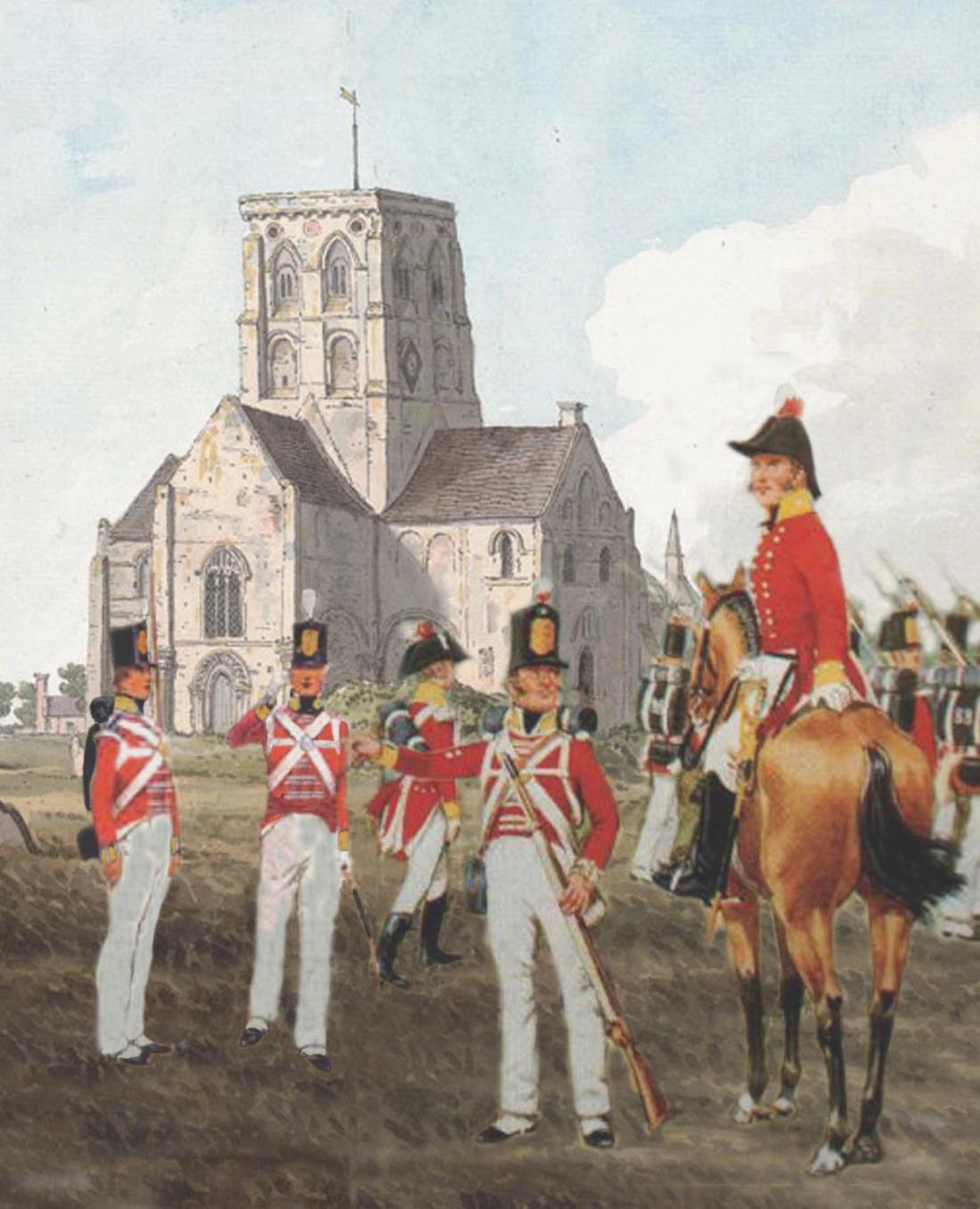
By the early 1800’s units of the regular army had started to arrive more often and a burial entry of May 1st 1804 states “Thomas Parker 27 Private 91st Regiment of Regulars collapsed on parade and died shortly afterwards.” – this was the famous 91st Regiment of Foot drawn from two Scottish counties better known as the Argyll and Sutherland Highlanders in later years.
Another burial of 18th October 1805 records that William Coltman 41 Quartermaster 1st Regiment of Dragoons “accidentally drowned in Lancing Brooks near Mr. Holmes’ farm.” Apparently he, ‘a much respected and sober man’ was riding back from Shoreham to Worthing when he mistook his way at Lancing and fell into French Brook on Mr. Holmes’ Old Salts Farm and not found until 4pm the next day. His horse was rescued still alive after 18 hours in the water. By coincidence the same day as that burial another Quartermaster of the same regiment named Russell broke his leg when his horse ran against a post near Old Shoreham.
A number of deaths from smallpox occurred in 1804 mainly involving the soldiers’ infant children and there were also casualties among Shoreham townsfolk. One final burial entry of note was that of Henry Medley Kilvington “a barrack-master near 60” buried on 12th February 1808 and whose memorial was once in St.Mary’s church but has since disappeared.
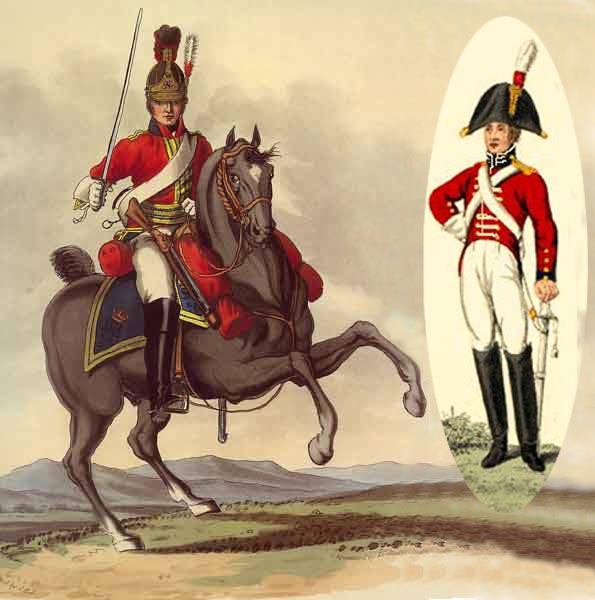
Apart from the regular infantry (the 78th Regiment of Foot in 1805, the 35th in 1806 and the 4th, 5th and 44th in 1814) other regiments here included cavalry units. The 4th Queens Own Dragoon Guards made an appearance in 1805 and again in 1809, the 6th Inneskillen (or ‘Inniskilling’ as it was often officially spelt) Dragoons from December 1805 to April 1807, the 11th Dragoons in 1806, the 7th (1811) and 10th Light Dragoons (1816) but by far the longest stays appear to be the 1st Regiment Kings Dragoon Guards whose register entries span from May 1804 to October 1805 then again in December 1807; and the 6th Dragoon Guards (The Carabiniers) from December 1805 to April 1807 which indicates that they were not both in Shoreham at the same time.
The Kings Dragoon Guards had fought at the battle of Blenheim 1704, the Netherlands Campaign of 1793-5 and, after Shoreham, took part in the Battle of Waterloo. The 6th Dragoon Guards specialised in fighting with a light, short-barrelled rifle (carabinier) and went on to participate in the Peninsula Wars in Spain. Both were cavalry regiments and their men and horses must have been stationed at New Barn as already explained
The number of regiments in Shoreham peaked at 9 in 1806 but thereafter rapidly declined as troops were shipped to Spain for the Peninsula Wars (1807 – 1814) and the threat of invasion subsided. However, the parish registers reveal another interesting flurry of activity in February, June and August of 1814 when the 4th, 5th and 44th Regiments of Foot were here – the first two perhaps prior to marching on for the larger transport ships at Portsmouth for service abroad. Interestingly though, the 44th at Shoreham consisted of at least a company of men (about 100) the remnants of the regiment that had returned to Lisbon the previous year still too sick or injured for active duties but fit for a recruitment party and defensive duties.
Thereafter the military activity in Shoreham seems sparse which is confirmed by a Brighton history of 1824 that mentions a military barracks in Shoreham that by then was ‘not of great magnitude.’ Shoreham historian Henry Cheal writes that this was situated on the south east side of Ravens Road which at the time of the 1782 Survey were plots 151 called Stone Croft and 49 with two tenements adjoining the west of the former. However, there is no record of this in the Land Tax records and, apart from a Sussex Imperial Yeomanry Camp around Buckingham Park during the early 1900’s, there does not appear to have been any further significant military occupation of the town until WW1.
Roger Bateman
Shoreham
June 2010 (updated December 2013)
Regiments at Shoreham – Entries from the New Shoreham Parish Registers (PR) having regimental annotation and Newspaper Reports (NR):-
(Old Shoreham registers show only two army-related entries for the same period)
Part of General Waldegrave’s Light Troop December 1759 NR
One troop of the Regiment of Dragoons February 1769 NR
Various winter quarters for the West Middlesex Regiment included Shoreham 1784 NR
The Radnorshire Militia wintered at Shoreham 1793 NR
The West Middlesex Militia commanded by Col. Cawthorne spent their winter quarters at Shoreham and nearby in 1794 NR
North Fencibles May 1795 (recorded as a ‘regiment’ but was in fact a militia) PR
Cumberland Militia March 1796; July, October and November 1808 PR
Cornish Militia 1797 PR
The first Northamptonshire Regiment of Militia were ordered to march to Brighton and Shoreham in four divisions. The third and fourth divisions to reach Shoreham Barracks on the 9th and 10th October 1798 NR
Derbyshire Militia 1799 PR
The North Gloucester Regiment of Militia returned from Ireland and stationed at Shoreham May 1799 NR
Sussex Militia October 1799, March and April 1804 PR
Hereford Militia 1799 and March 1804 PR
The 55th Foot marched from Canterbury in three divisions, the second division of three companies were split between Shoreham, Steyning, Bramber, Beeding and Henfield May 1800 NR
South Gloucester Militia February 1803 and March 1804 PR
91st Regiment of Regulars May 1804, June 1809 PR
Glamorgan Militia April 1804 PR
The 91st Regiment of Infantry left New Shoreham to replace the Dorset Militia commanded by Colonel Bingham which regiment in turn replaced the 91st at Shoreham, Worthing and Littlehampton May 1804 NR
Dorset Militia June 1804 PR
The Dorset Militia left Shoreham, Worthing and Littlehampton for Eastbourne camp July 1804 NR
The South Hampshire Militia left Portsmouth for Shoreham June 1805 NR
The North Hants Militia left Shoreham for Portsmouth July 1805 NR
1st Regiment (Kings Dragoon Guards) May, June, August 1804; August, October 1805; April and December 1807 PR
North Hants Militia March, April 1805, 1807 PR
2nd Battalion 78th Regiment of Foot September 1805 PR
4th Regiment of Dragoons (Queens Own Dragoons) October 1805; June, July1809, 1810 PR
6th Inneskillen Dragoons Dec 1805 PR
South Hampshire Militia left Shoreham for Littlehampton and were replaced by the West Essex August 1806 NR
6th Dragoon Guards (The Carabieners) Feb, March, April, May, June, September, November 1806 and April 1807 PR
The West Essex Militia left Shoreham for Portsmouth and the South Hants Militia were at Southampton on their way to Shoreham having left Weymouth June 1807 NR
South Hants Militia March, April, July 1806; June, July 1807; January, February 1808 PR
11th Regiment of Light Dragoons April 1806 PR
35th Regiment of Foot April 1806 PR
South Devon Militia May 1806 PR
West Essex Militia Sept, Oct, Nov, December 1806; January 1814 PR
8th Regiment of Foot March 1808 PR
The 11th Royal Veteran Battalion arrived in Shoreham from Guernsey June 1808 NR
Montgomery Militia June, July, October, November, December 1808 PR
Detachments of the 3rd and 4th Dragoons and the 14th Light Dragoons of the German Legion in all totaling 300 men and horses from Shoreham Barracks left for Plymouth to embark for Portugal January 1811 NR
1811 The Bedfordshire Militia marched for Shoreham, (Little)Hampton and Bognor Rocks to relieve the 68th Regiment February 1811 NR
7th Dragoons Sept & Nov 1811 PR
The 7th Dragoon Guards, part of which was quartered at Shoreham left for Kent January 1812
A small detachment of the 2nd Battalion of the King’s German Legion marched from Bexhill to Shoreham and Steyning August 1812 NR
44th Regiment of Foot Feb 1814 PR
5th Regiment of Foot June 1814 PR
4th Regiment of Foot August 1814 PR
10th Dragoons June 1816 PR
Reference Sources:-
1782 Survey of New Shoreham
1782 Survey Map
Land Tax Records for New Shoreham
Parish Poor Rates for New Shoreham
Parish Registers for New Shoreham
The Story of Shoreham by Henry Cheal
Newspaper & Broadsheet Reports from the British Library Archives
Alan Rowe for information on the 44th Regiment of Foot


